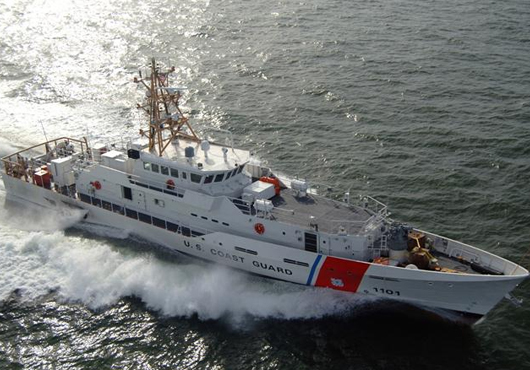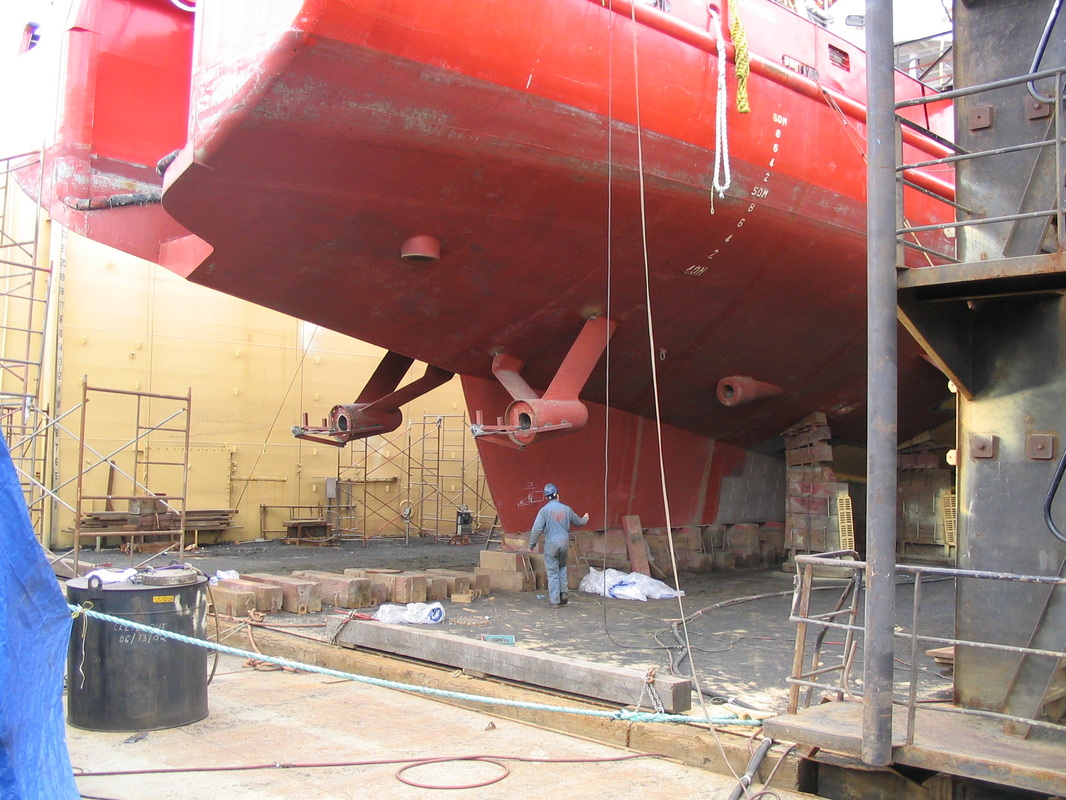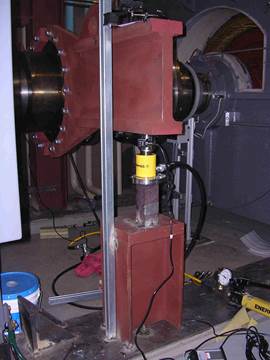Coast Guard and Other
|
|
Canadian Coast GuardSupport of the Canadian Coast Guard Fleet is on-going. Propulsion shafting alignment and vibration services for new construction as well as refit, troubleshooting, and repairs are provided. The following is a partial list of the vessels have been serviced:
|
United States Coast GuardSupport of the United States Coast Guard Fleet is on-going. Propulsion shafting alignment and vibration services for new construction as well as refit, troubleshooting, and repairs are provided. The following is a partial list of the vessels have been serviced:
|
USCG - Fast Response Cutters (FRCB)
|
CCG Offshore Fisheries Research Vessels (OFSV) (1 x 2250 kW)Three Offshore Fisheries Science Vessels (OFSVs) for the Canadian Coast Guard are under construction by Vancouver Shipyards. The vessels are 63.4 metres in length with a design displacement of 3212 tons. The vessels have a single screw propulsion system. The 5 bladed fixed-pitch propeller is driven by a double-wound electric motor rated at 2250 kW at 135 RPM.
LamaLo Technology Inc. (LLT) has been contracted by Vancouver Shipyards Co. Ltd. (VSY) to provide specialized engineering analysis services with respect to the propulsion shaft alignment and vibration on the OFSVs. This includes a review of the design arrangement, finite element modeling of shafting vibration and alignment, development of alignment procedures, and measurement of final alignment. The first vessel CCGS Sir John Franklin was delivered in June 2019. The second, CCGS Capt. Jacques Cartier, was delivered in December 2019. The third vessel, CCGS John Cabot, was delivered in 2020. |
CCGS Jean Goodwill - Arctic Class 2 (2 x 6720 kW)The CCGS Jean Goodwill (Goodwill) is an icebreaking anchor handling tug supply vessel (AHTS), DNVClass-10, and is being converted to a medium class icebreaker for the Canadian Coast Guard at Chantier Davie Canada Inc. and will be rated as Arctic Class 2. Goodwill is 87.5 m long and has a service speed of 11 knots. The Goodwill has a twin-screw ducted propeller configuration. Each of the 4 bladed controllable pitch propellers are directly driven by two diesel engines with a rating of 3840 kW and 2880 kW, both at 600 RPM through double-input single output gearbox. The propulsion shaft is approximately 34.5 m long and is supported by a three oil-lubricated sterntube bearings, and three intermediate shaft bearings.
The component and system design, and documentation, of the propulsion shafting system were reviewed and assessed. Theoretical analyses of the static alignment condition and lateral (whirling) vibration were conducted and alignment procedures developed. Final alignment was conducted using the strain gauge technique. The vessel was delivered in November 2020. |
CCGS Gordon Reid – SAR Cutter
|
MV Oscar Dyson – NOAA Fisheries Research Vessel (1 x 2300 kW)National Oceanic and Atmospheric Administration (NOAA) 40-Day endurance fisheries research vessels (FRV40-1) are under construction at VTHalter Marine Moss Point Yard. The vessels are 209' long with a beam of 49', a draft of 19.3' / 30.0' (center board up/down), a full load displacement of 2,240 metric tons, and a design speed of 20 knots. The ships have a range of 12,000 nautical miles, a trial speed of 14 knots, and carry a complement of 39 persons.
The vessels have a single screw propeller configuration. The 5 bladed fixed pitch propeller is driven by two tandem DC Motors, each rated at 1150 kW at 134 RPM. The propulsion shaftline length is about 49' long, and is supported by one sterntube bearing, one intermediate shaft bearing, and one support bearing on the thrust shaft. Each of the two motor rotor shafts is supported by two bearings. LamaLo Technology was contracted to conduct a theoretical propulsion shaftline alignment and vibration analysis, provide the propulsion shaftline installation and alignment procedures, and to measure and assess the shaft torsional and lateral vibrations during sea trials. The strain gauge technique was used to conduct the final alignment prior to chocking. All four (4) vessels were delivered by 2009. LLT was contracted by Marinette Marine Corporation to conduct similar work for the fifth vessel of this class (NOAA FSV-6). This vessel was delivered in 2013. |
Center for Advanced Power Systems (CAPS) Test Bed (2 x 2500 kW)
The Center for Advance Power Systems (CAPS) Test Bed Facilities has been developed to conduct applied research on marine propulsion motors. It consists of two tandem 2.5 MW AC Electric motors driving a test motor. The AC motors are used to replicate propeller loads on the test motor. LamaLo Technology Inc. (LLT) was contracted for the following:
· Install and test the torque measurement system
· Provided expertise on the physical calibration design and execution
· Conduct the theoretical shaft alignment and vibration analysis
· Measure and assess the shaft whirling vibrations and static alignment condition (strain gauge technique)
A static physical calibration was conducted on the torque strain gauges. Torque was applied by two hydraulic rams pressing against two opposite arms mounted on the flange of the shaft, providing a pure torque load. A static torque was applied to the shaft of up to 303,000 ft-lb. Both a clockwise and counter-clockwise torque was applied. The error in the value of the torque calibration factors was calculated to be less than 1% of full scale. The linear regression coefficient (R2) was better than 0.9994 for all the tests performed.
A full power test was conducted in 2004 on the Test motor. The shaft vibrations and alignment condition were acceptable.
For more information see http://www.caps.fsu.edu
· Install and test the torque measurement system
· Provided expertise on the physical calibration design and execution
· Conduct the theoretical shaft alignment and vibration analysis
· Measure and assess the shaft whirling vibrations and static alignment condition (strain gauge technique)
A static physical calibration was conducted on the torque strain gauges. Torque was applied by two hydraulic rams pressing against two opposite arms mounted on the flange of the shaft, providing a pure torque load. A static torque was applied to the shaft of up to 303,000 ft-lb. Both a clockwise and counter-clockwise torque was applied. The error in the value of the torque calibration factors was calculated to be less than 1% of full scale. The linear regression coefficient (R2) was better than 0.9994 for all the tests performed.
A full power test was conducted in 2004 on the Test motor. The shaft vibrations and alignment condition were acceptable.
For more information see http://www.caps.fsu.edu
M/Y “Christina O” – Pleasure Yacht
|















